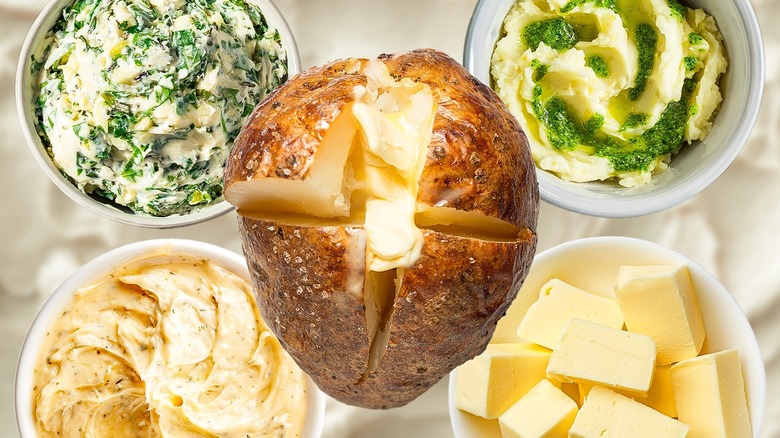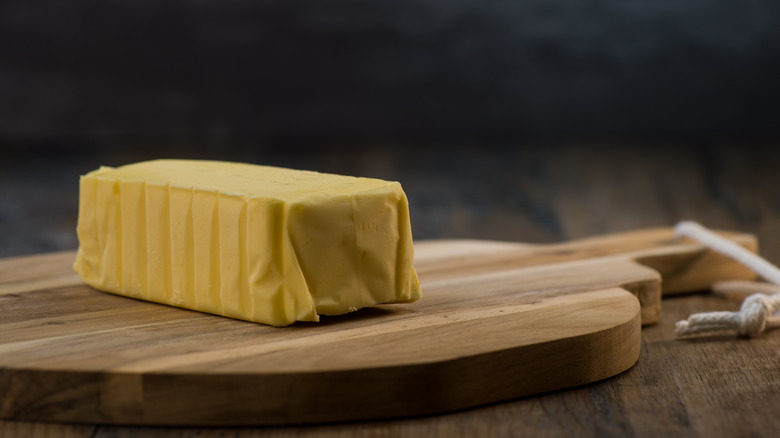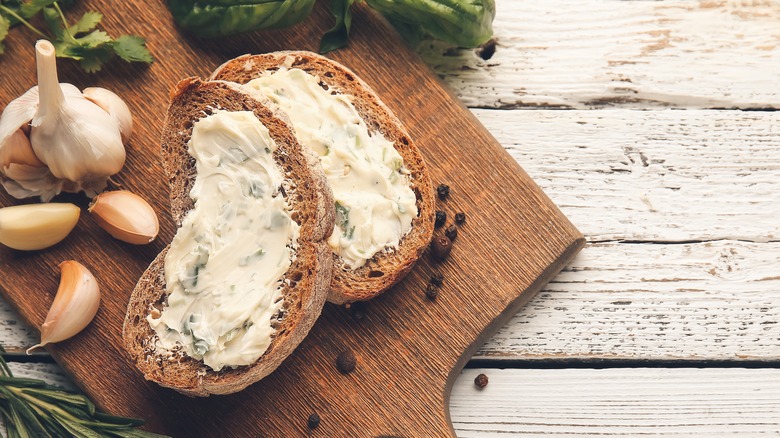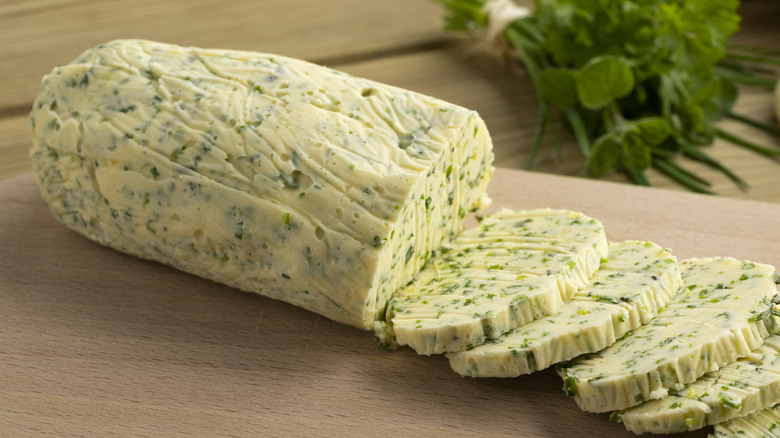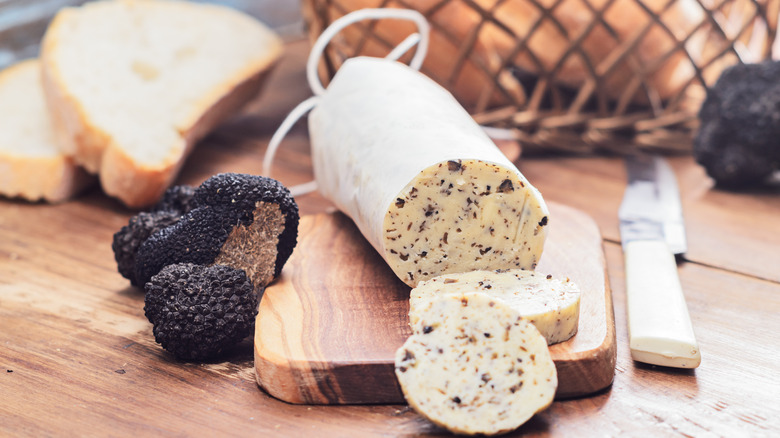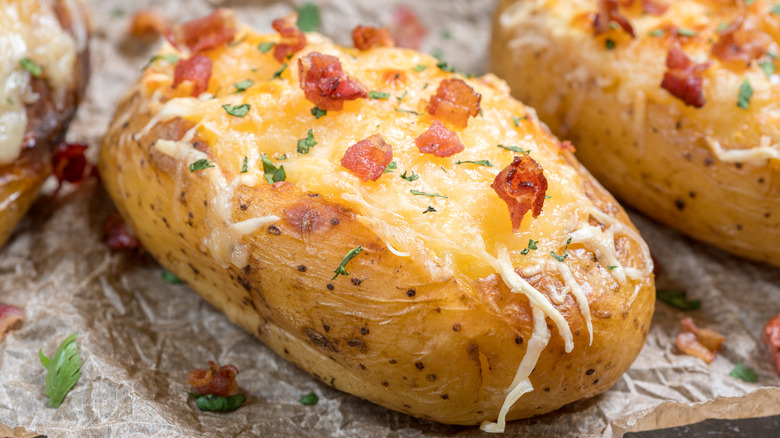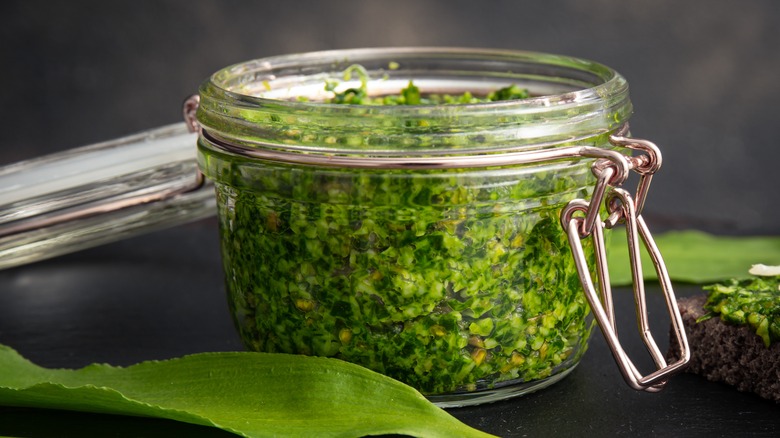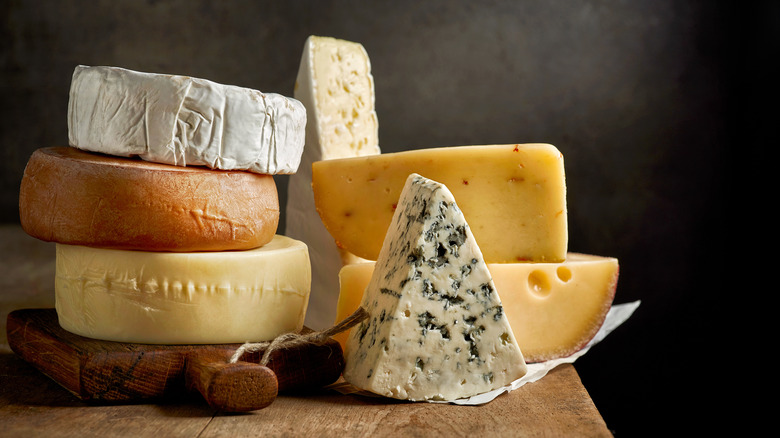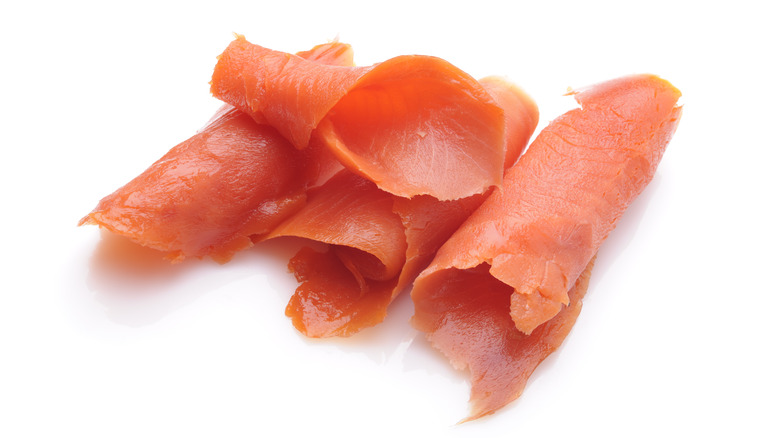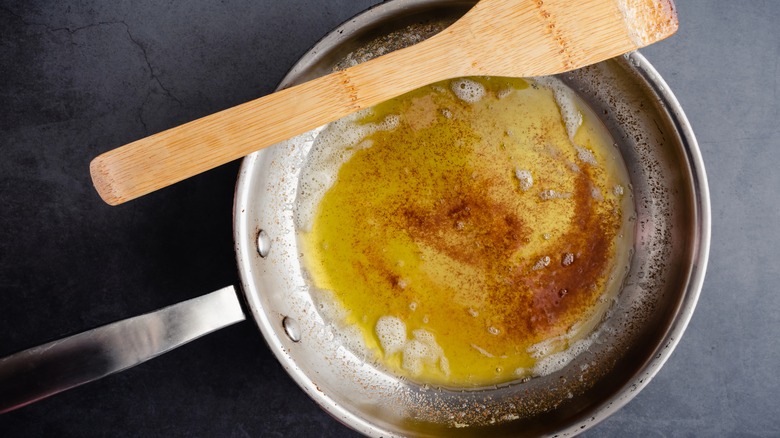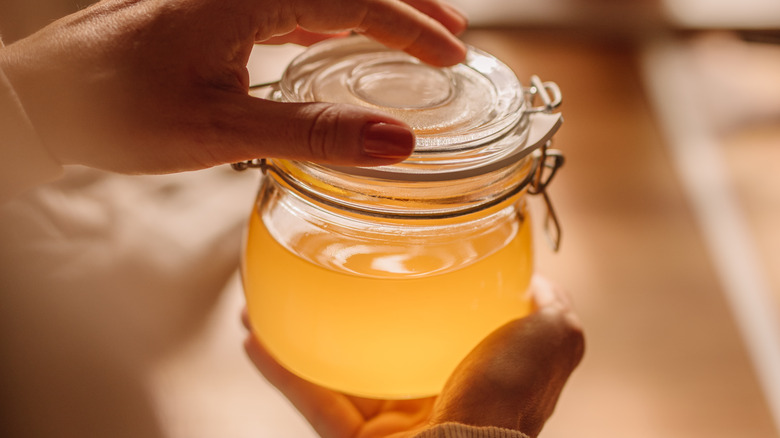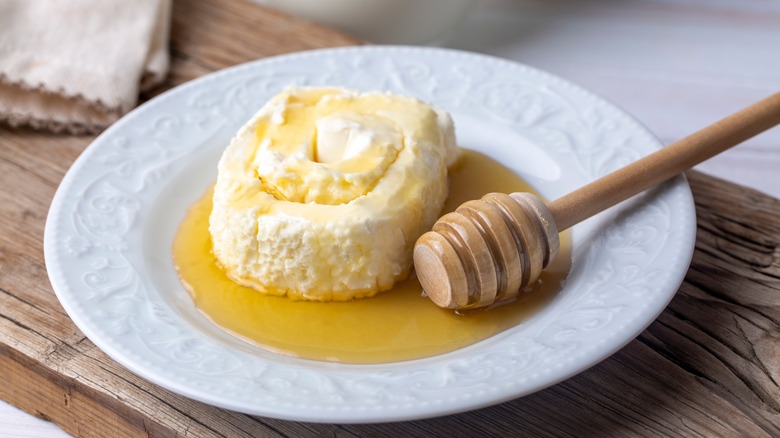11 Butters You Should Be Putting On Baked Potatoes
Baked potatoes are what comfort food dreams are made of. They're simple and easy to prepare and act as a blank canvas ready to be topped with assorted deliciousness. The crispy skin and fluffy insides are the perfect base for all your favorite toppings. After all, potatoes don't bring the flavor to your plate on their own. It's the toppings that elevate the humble baked potato into something spectacular. Sour cream, bacon bits, shredded cheese, and chives are the traditional baked potato toppings, but if you want to give your spuds a monumental flavor boost with something simple, just add butter.
Butter makes everything better, especially baked potatoes, and there are numerous types and styles to choose from. Whether your favorite is European, salted, unsalted, or compound butter, this dairy product is a simple way to amp up the flavor of baked potatoes. Compound butter, for example, combines all of the best things about butter with the taste and texture of the ingredients added to it. It can be tweaked to be sweet, savory, spicy, or mild and is an excellent way to shake up your baked potato game. Here are a few buttery options to step up your spuds.
European-style salted butter
European-style salted butter is known for its exceptional creaminess and distinctively rich flavor — both of which melt perfectly into a baked potato. You'll also get some flavor from American salted butter, but it lacks the hallmark velvety smoothness and pronounced flavor that comes naturally with European-style butter. Most salted butter on supermarket shelves contains, on average, about ¼ teaspoon of salt per ½ cup of butter. This amount may vary because there are no requirements for salt content. Regardless, you can count on the salt to amplify the potato's taste.
The main difference between American butter and European-style butter is the amount of butterfat they each contain. Butterfat is the fat that naturally occurs in milk and cream. When the cream is churned, the fat, or milk curds, are transformed into butterfat. European butter is churned for a longer period of time to produce butter with more fat.
The USDA standards for butter require butter produced in the United States to contain a minimum of 80% butterfat. In Europe, butter must contain between 82 to 90% butterfat. These percentages may seem small, but even this tiny increase in fat content can change both the taste and consistency of the butter produced. If you can't find European-style butter, look for Amish-style butter at your local grocery store or farmers' market. Amish butter typically contains 84 to 85% butterfat.
Garlic butter
Garlic and butter are a match made in heaven, and when they're stirred together to create garlic butter, they're a delicious addition to everything from homemade garlic bread to baked potatoes. Together, the ingredients add a rich, savory layer of flavor that turns a plain potato into a delectable treat. Top your potato with a dollop of garlic butter for maximum flavor. It will melt into the potato's nooks and crannies, taking the garlicky goodness with it.
In its simplest form, garlic butter is made by stirring minced garlic into softened butter. You can smash the garlic into a paste for a smoother butter without solid bits of garlic. Adding chopped fresh herbs like parsley, thyme, or basil will add another level of flavor to your garlic butter and your baked potatoes.
If you have time, consider roasting the garlic to make a roasted garlic compound butter. Creamy roasted garlic will blend effortlessly into softened butter and impart a ton of flavor. Be sure to let the roasted garlic cool completely before using it. Otherwise, if it's too hot, it will melt the butter.
Consider making a big batch of garlic butter so you have it on hand for baked potatoes and anything else you want to make more delicious. Wrap your butter in wax or parchment paper, seal it tightly, and store it in your fridge or freezer.
Herb butter
Herb butter is an excellent way to put leftover herbs to use. Rinse the sprigs, pat them dry, chop them up, and add them to the softened butter. Making herb compound butter from scratch allows you to customize it to suit your tastes and opens up the opportunity for mixing herbs to create innumerable butter variations. Whether it's the bright, citrusy notes of parsley, the mild oniony undertones of chives, the woody aroma of rosemary, or thyme's delicate floral taste, herb butter is a delicious choice for a baked potato topping.
You can still make herb butter if you don't have fresh herbs on hand. Dried herbs are also flavorful, but you'll have to adjust the amount you use because they have a more concentrated flavor. As a general rule, use 1 teaspoon of dried herbs for each tablespoon of fresh ones.
Adding herb butter to your baked potatoes will also give them a stunning visual appeal. The bits of herb speckled throughout the butter add a fun pop of color to your baked potato, making them as nice to look at as they are to eat.
Truffle butter
Want to turn your baked potatoes into an elegant side dish worthy of a dinner party? You can accomplish this easily by topping them with truffle butter. Truffles are a type of fungi that grows underground. They're harvested by truffle hunters who use specially-trained pigs or dogs to sniff the fungi out.
Truffles are a luxurious ingredient that can be used in numerous ways. It was once relegated to the menus of fancy restaurants due, in part, to its extremely high price. But in recent years, truffles have made their way into some high-end grocery stores, home kitchens, and butter. On their own, truffles have a pungent, earthy flavor, but when they're added to butter, the result is a rich and delectable truffle butter you'll want to put on everything. Both professional and home chefs add truffle butter to an array of foods, from pasta to scrambled eggs to risotto.
Truffle butter is made by combining finely grated truffles with softened butter. Truffle oil and fresh herbs can also be added for a well-rounded flavor. This buttery creation is packed with umami, making it a delectable addition to baked potatoes, which are inherently bland on their own. If you don't want to make your own, you can also purchase truffle butter in retail stores and online.
Bacon butter
Bacon is fantastic in all things — whether it's tucked into a classic BLT, wrapped around Brussels sprouts, or simmered into an easy bacon jam. Bacon butter, made by stirring chopped crispy bacon into softened butter, is a culinary revelation. Its smoky, salty goodness perfectly complements butter's rich, creamy texture. Smother your perfectly baked potato in bacon butter, and you have a match made in flavor heaven.
You can make your own bacon butter by first cooking bacon until it's crispy. Then, place the cooked bacon on paper towels to drain any excess oil. Once the bacon is completely cool, chop it into small, uniform pieces before stirring it into the butter. It's imperative that you make sure the bacon is completely cooled before adding it to the mix. Add it when it's still warm, and you'll end up with melted butter instead of the creamy, spreadable type that is perfect for biscuits or any other application. You can also add herbs or spices to suit your taste.
Pesto butter
Pesto is a classic Italian sauce known for its bright color and taste. This delightful blend of fresh basil, pine nuts, garlic, parmesan cheese, and olive oil is traditionally used as a sauce for pesto pasta, but it can also be used for other proteins or for a plate of savory tomato pesto scones. Pesto can liven up potatoes, too, especially when mixed with butter.
The great thing about pesto and pesto butter is its versatility. You can purchase store-bought pesto, but if you're making it from scratch, you can better control the intensity of each flavor. Add more parmesan for a cheesier pesto butter, or tone down the garlic for a milder flavor. You can go all in on a pesto butter baked potato by stirring the pesto directly into the spud's flesh. Finish it with a generous sprinkle of parmesan cheese and finely chopped pine nuts for a truly divine potato experience.
Once you make your pesto butter, don't let it go to waste. Schmear it on a slice of crusty Italian bread, melt it into your scrambled eggs, or toss it with roasted or grilled vegetables for a flavorful boost.
Cheesy butter
Cheese and butter are a dairy duo made for baked potatoes. Butter is a given for the tasty spud, and when you add your favorite cheese into the mix, an ordinary baked potato becomes a culinary masterpiece. Though there are many cheese varieties, two standouts come to mind for use in cheesy butter: parmesan and blue cheese.
Parmesan cheese is extremely versatile in the kitchen. It can be used to amp up the umami flavor of a protein, and no plate of pasta is complete without the obligatory sprinkle of freshly grated parmesan cheese. Parmesan butter makes it easy to spread the cheese's nutty essence throughout your baked potato. For a bolder tater, look to blue cheese butter. It's a tasty addition to mashed potatoes, and that deliciousness also extends to baked potatoes. Blue cheese butter adds a tangy dimension to the spuds, and its lush texture blends exceptionally well with room-temperature butter.
Depending on your preference, you can choose a cheesy butter that will add a rich, complex depth of flavor or a bold sharpness to your baked potatoes. Either way, cheesy butter is what your next baked potato needs.
Fish butter
Need a new flavor to make your baked potatoes even better? Fish butter is the secret sauce to an extraordinary baked potato. It's a unique and imaginative pairing that combines the savory richness of butter with the distinctive briny notes of fish. This umami-packed combo creates a savory fusion that will redefine your baked potato experience.
Fish butter can be made by blending fish like smoked salmon, anchovies, or smoked trout into softened butter. We recommend using unsalted butter if you're going with a smoked fish since the protein is typically salty enough on its own. The fish blends into the butter, creating a velvety spread full of the briny, slightly salty taste of the fish. It's an unexpected combination that adds a burst of flavor to baked potatoes and more.
You can elevate fish butter by adding chopped fresh herbs like chives, dill, or even chopped green onions. However you mix it, fish butter will add a bold and savory dimension to your baked potatoes and more. Make a hefty portion of fish butter, and you'll be ready to give everything from grilled seafood to pasta sauce additional flavor. Spread it on a baguette slice or stir it into seafood risotto for a mouthwatering flavor boost.
Brown butter
French-style brown butter, also known as beurre noisette, is the secret to upgrading some of your favorite foods. It can be a base of flavor for cookies, brownies, sauces, and gravies — and if you're willing to try something a little different, baked potatoes, too. Brown butter has a distinctly nutty, caramelized flavor that will seep into every corner of your baked potato, creating a delicious blend of texture and taste.
If you have butter in your fridge, you can make brown butter without any additional ingredients. All you have to do is melt butter over medium heat. Stir it or swirl the pan gently to ensure even melting, then remove the butter from the heat once it turns golden brown. You'll need to watch it closely because butter burns quickly, and once it passes this threshold, there's no saving it. The sharp, acrid butter taste will overpower anything you add it to.
You can drizzle your brown butter over your baked potato's fluffy filling. It will add a subtle, toasty richness and silky, luxurious texture that perfectly complements the potato.
Ghee
Simple combinations in the kitchen are great, but sometimes, it's worth taking a few extra steps to create something extraordinary. Making or buying ghee to add to your baked potatoes is one example. Regular butter is awesome on potatoes of all kinds, but ghee turns the flavor on full blast. There are numerous ways to use ghee in your cooking, including adding it to your baked potatoes for a low-effort yet tasty addition.
Ghee is essentially clarified butter that has been cooked for a bit longer. Once the milk solids separate and settle at the bottom of the pan, the butter is strained and ready to use. To make ghee, once you've reached the clarified butter stage, the butter should still be cooked until the milk solids at the bottom of the pan start to brown. This additional cooking time gives your butter the benefit of those toasty brown bits that impart more flavor and color.
There are many different opportunities to intertwine ghee and your baked potato. Brush the potato with the ghee before you bake it to promote a crispy skin. Or, drizzle ghee over the baked potato once it's cooked to allow its nutty flavor and aroma to blend seamlessly into the spud's fluffy filling.
Honey butter
Baked potatoes don't have to be savory. We're all accustomed to baked potatoes loaded with savory toppings like cheese, chives, or crumbled bacon, but you can also enjoy a potato, especially a baked sweet potato, with additions like honey butter. It works great slathered on warm bread, so why not on a hot baked potato?
You can whip up a batch of honey butter in minutes by stirring the two together. Add a pinch of salt and seasonings like cinnamon and nutmeg for additional flavor. Other optional flavorings include vanilla extract, ground ginger, and cardamom. You can adjust the amounts of all the ingredients to create your own honey butter blend.
If you can't fully embrace the sweetness of honey butter on baked potatoes, add a savory spice or two to ease the transition. Spiced honey butter and honey-curry compound butter are the perfect gateway butters because they're at the midpoint of sweet and savory. Adding chopped fresh herbs like thyme, parsley, and rosemary are also tasty options that can sway the butter's flavor and balance out the sweet notes.
